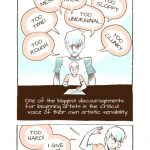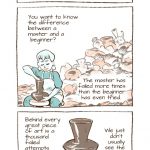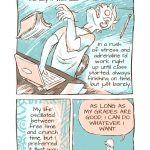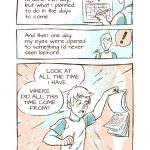Here is a comic I made for the newest issue of Broken Pencil Magazine (#60, summer 2013).
Note: I ignored most of my own advice to get this thing done.
Another note: Follow the permalink to read it bigger: http://dakotamcfadzean.tumblr.com/post/57543870239/here-is-a-comic-i-made-for-the-newest-issue
Tag: motivation
Untitled
I have this written on my chalkboard right now. It’s my little daily reminder to myself, and I need it. As damn stubborn as I can be, I seem awfully willing to give up when it comes to things that are important to my dreams. They’re my dreams, and I need to damn well remember that being bull-headed stubborn is what wins this sort of fight.
You didn’t write today? It’s okay. Keep going. Don’t give up.
You haven’t posted to your tumblr in a week? You haven’t achieved any of the (admittedly difficult) goals you set yourself in the last two weeks? You haven’t caught up with your wordcount? You haven’t hit your query quota for the day? You got your first reject?
Wait. Stop. Listen to what you’re telling yourself. Now stop it and look at what you have done.
You’re writing almost every day. You’re researching agents twice a week. You’ve submitted 6 queries AND received your first rejection!
Look at you. You’re moving. You’re doing. You’re heading in a forward direction. You’re not failing.
It’s OKAY. Keep going. Don’t you dare give up.
Untitled
Canon.
Melanie Gillman made my comic mantra.
I need to hand this by my desk, oh my god.
Untitled
This essay is kind of the second part of an essay on taste that can be read here:
Untitled
Do it wrong.
Cartoonists, writers, musicians, actors, filmmakers, we all get the same questions. And we all have boring, stock answers like ‘draw every day’ or ‘practice a lot’. Sometimes it’s because we don’t know what we did right. But the real reason is that every bit of advice we give you has an expiration date. The world of art is always changing. The things people like, the way those things are distributed and sold is always changing. By the time you put in all that practice to get good at what someone else told you is the way things are done, they aren’t done that way any more. The only sure way to become great at what you do is to break the rules. Not for the sake of being a rebel, but so that you can make something only you can make, in a way only you can make it. If you do something wrong well enough, it becomes the new right. So here are 5 steps in the right way to do it wrong.
STEP 1: Practice
To become a good artist:
Focus on making perfect art. Don’t show weakness. Use the tools that everyone else recommends. If you can’t draw hands, put them in pockets. If you can’t draw feet, crop them off the page. If you’re not very good at an instrument, play something easier. If you’re not knowledgable in a subject, write about something else.
To become a great artist:
Just make a bunch of crappy art. Do things wrong. Trust me, even the art you think is great, give it a few years and you’ll think it’s crap. So you might as well shoot for the moon. Grab tools that no one else has ever even imagined using, and see what happens. Draw everyone on horses even though you know the legs are going to come out all weird. Perform that long, flowery monologue you know you’re going to forget the words to. Film that science fiction epic even though the only creature effects you can afford are sticking Halloween stuff on your cat. Doing things you know you can’t do well so that you can do them later is the whole idea behind exercise.
STEP 2: Taking criticism
To become a good artist:
Show your only your best work to people you trust. Enjoy the praise, and ignore the haters.
To become a great artist:
Share your work with everyone, even the jerks. Put it online, show it to strangers. Show them the stuff you’re proud of, and the stuff you’re not sure of. When you show just your average art, people have nothing to say, so they just give you empty praise. But show them something that can be improved, and they’ll tell you about it. The stuff they tell you is gold. Don’t just be disappointed, write that crap on a post-it and put it above your desk. Think about it when you work. Each and every one of them gave you a free mini art lesson. If they were dicks about it, that makes them a bad teacher, it doesn’t make you a bad artist. There’s a very good chance that they are wrong. But thinking about what they said, and why you disagree with it, helps turn that problem into a technique. Sifting through critiques is like panning for gold. Sift through the muck of poor wording and trolls to your own little takeaways. Write it on a post-it note and put it above your desk. Think about it while you draw. Use it.
STEP 3: Improving
To become a good artist:
Did you try something new and get a bad reaction? Oh no! Listen to the advice people give you and take that element out of your work. Make something people like.
To become a great artist:
Did you try something new and got a bad reaction? Awesome. There are two reasons that people say negative things about your art: because they see something worth improving, or because you’ve somehow struck a chord. Either way, you made them feel something. Figure out how you did it, and how best to use that skill. Did something you did make someone angry? If you offended or hurt someone, you now know how to avoid doing that in the future. But if you made someone feel something about the story or characters, you now have a skill that you can hone and use as a tool at a better point in the story. To make people angry, sad, happy, uncomfortable, or in any way emotional when looking at your work is a skill that few have because we’re so used to beating it out of our work. Many people compensate for this by adding shock value. You can learn to do it with emotion.
STEP 4: Dealing with rejection
To become a good artist:
Find out where art like yours is being published. Submit to them! Rejected? That’s too bad! Try again! Send them your new stuff every year! Never give up! One of these years, it will all work out!
To become a great artist:
Getting rejected is great! When you get a rejection letter, you aren’t losing a job, you’re gaining one. Finding a venue and an audience is now up to you, which is great, because if you’re successful, you’ll be the one getting rich from your work. All of those places were created because someone needed a new place to put a different kind of work. You’re now in the same boat.
STEP 5: Building a career
To become a good artist:
After a lot of practice and study, take all the advice people have given you, follow their lead. Make something you know will be successful, put it in all the right venues.
To become a great artist:
Do it wrong. Don’t do it right just because of all the people around you who say ‘that’s not art,’ ‘that’s not music, ‘there’s no money in that,’ ‘it’s not a real book unless it’s in print,’ etc. Some of those people will be your heroes. Every generation hates the next generation’s music. Every generation of artists thinks the next generation are hacks. Following the leader is a good way to make art that pleases people in the moment, but doing something that breaks all of the rules is the way be the leader and make something historic. Tell a story only you can tell in a way only you can tell it. When you see a piece of new technology, a piece of ancient technology, an interesting bit of trash on the street and think ‘I could put art on that’, then put art on that. You’ll be reaching new people in places no one else is even trying. There’s no money in ANYTHING until someone puts something great on it. When someone tells you you’re doing it wrong, that’s your clue that you’re doing something that could change all of the rules, and a few decades from now, your style will be the one someone’s drilling into a beginner’s head, and that beginner will be coming to you for advice. Feel free to tell them what you did right, but be sure to also tell them: Do it wrong.
Untitled
I’m gonna tell you guys a secret about chasing your dreams.
It’s not the cliche crap, about never giving up, or overcoming adversity. You know all that. If you relate following a goal to The Odyssey, everybody knows about all the monsters you have to slay, battles you have to win, cyclopses you have to outwit, and all that.
But what no one tells you is the the adversity is not the hardest part to overcome. The hardest part is comfort. To return to our The Odyssey metaphor, the hardest part of his journey had to have been the land of the Lotus Eaters.
There were no six-headed monsters on that island, no sirens, no angry deities. There were just some nice dudes offering some fruit that made Odysseus and his men feel awesome. They offered a home, they offered rest, they offered community. This wasn’t exactly Odysseus’ goal, but it was another version of it. The men could have stopped their quest RIGHT then and there, adjusted their goal to find A home instead of THEIR home, and been done. No more cannibals, no more witch-goddesses, no more being turned into pigs. But Odysseus didn’t stop there. He wanted HIS home. He wanted HIS family. He knew that if he stayed one second longer, it could jeopardize his chance to ever accomplish his real goal. He left, knowing that he was giving up his safety net, and possibly risking everything.
I’ve had this experience twice.
In 2007, I was living in India, working as a trainer for Citibank. It had taken a couple of years of adversity to get to where I was… but at that point I was being paid INCREDIBLY well for doing, well, next to nothing. I was there because it looked good on paper to say they had an American trainer on staff, but in reality their employees has no time to attend training. I made $5000 a month, was provided with an apartment, a maid, a personal driver, and spent most of my workday watching DVDs in the library. It was a very comfortable place to be.
But my goal has always been to have adventures and make my own art. This wasn’t exactly my dream, but it was another version of it. I was having adventures a’plenty, and I was making some art, but my job involved spending my nights in a call center (that I couldn’t bring paper in or out of) and my days to exhausted to draw. I made very little art. My graphic novel had been on hiatus for six months. I even lost some big opportunities…. a publisher wanted to run my comic Aki Alliance right alongside Diary of a Wimpy Kid right before Wimpy Kid became as huge as it did, but I lost the gig because of my long hiatus.
It was terrifying to step away from that oh-so-comfortable safety net. Everyone told me I was living the dream, but I knew I couldn’t sit doing nothing forever. Even though I’d only been paid to make a comic a few times, and had no idea how to make a living at it, I knew I had to try. If I took this step, it was going to be back to fighting monsters. I didn’t want comfort, I wanted to follow my dream. I quit.
I started something called Cartoon Commune. I did custom comics at a flat rate. Boyfriends as superheroes, how-we-met comics for weddings, promotional comics for trade shows…. and just like Odysseus, I was right back into adversity. All nighters. Customers that never paid me. A whole year where I was so broke I had to live on the floor of a broom closet of a friend’s art school and shower at the community gym.
But all that perseverance paid off. Cartoon Commune became a very successful endeavor. It allowed me to travel the world and make a decent living off of comics. Not nearly as much as I made in India, but enough to have an amazing life.
Everyone told me I was living the dream. Well, a dream. But only a version of my dream. I’ve been having adventures and making art, but not MY art. I have a folder on my hard drive with thousands of pages of comics. Comics for brides, grooms, boyfriends, girlfriends, CEOs, rock stars, famous people I can’t name because of nondisclosure agreements. But none of them are for me. They’re not my comics.
I’ve taken time off to draw some of my own books, having to choose the simpler-to-draw scripts so that I can get them done in between Cartoon Commune commitments, and every time it has been an amazingly rewarding experience.
Recently, I got to the point, where I knew it was time to take the big, scary, next step.
I quit the Cartoon Commune. I passed it on to its new manager, Chad Thomas, and lost my safety net. As of 12 hours ago, when I drew the last line on my last Cartoon Commune comic, I’m done. I’m now not just a full-time cartoonist, I’m going to make my OWN comics full time. Once again, I don’t entirely know how to do that. I’ve had success recently selling creator-owned comics, but I realize that it was a group effort and my contributions weren’t necessarily the most popular part of the package. I have no idea how people will respond when I launch projects of my own.
There will be adversity. There will be battles to fight, and monsters to slay. As a recently married man, those battles have higher stakes than ever. But I am ready.
I’m gonna go make some stuff.
I hope you like it.
Twelve Things You Were Not Taught About Creative Thinking In School
Twelve Things You Were Not Taught About Creative Thinking In School
Some inspiration to get y’all pumped up for the week!
An excellent breakdown. The most important, in my opinion, is “creativity is WORK.”
Untitled
ART HARDER

























